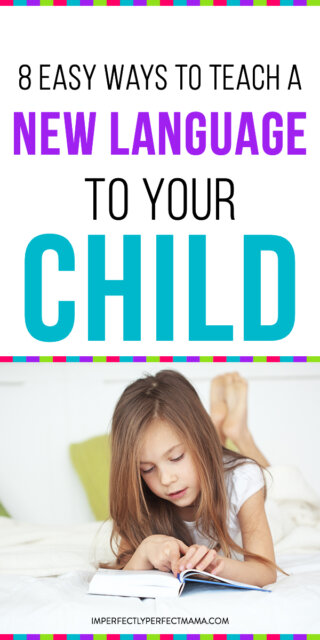Learning a second language is a life skill that improves both cultural awareness and cognitive function.

But how can you effectively teach your kids a second language if you don’t speak it or don’t speak it well?
One of the tenets of Imperfectly Perfect Mama is to embrace imperfection, and that’s applicable for language learning too.
You don’t have to be perfectly bilingual to introduce your child to a second language. You just have to want to do it.
Thanks to the internet, there are many practical and easy ways to go about it regardless of your command of the target language—all of which can be done at home.
How to Expose Your Child to a Second Language
First, make sure you offer a selection of activities that are fun and make your little one feel comfortable.
Second, whenever possible, make it kid-centered. That means giving your child the power to choose how and when they use the target language.
And, if they need a break, give them a break. This shouldn’t be a chore for you or them.
Finally, don’t worry about how old your kids are.
It’s long been stated that kids should be exposed to languages as early as possible (i.e., before three years old) but that’s somewhat of a myth. Yes, young children are more apt to learn correct pronunciation (meaning they may have little to no accent when speaking the target language) and “better long-term grammatical skills.”
But it’s not the end-all and be-all of language acquisition.
Studies have shown that older children, teens, and adult learners are better able to acquire vocabulary and grammar rules than young children.
So don’t beat yourself up that the language-learning train has left the station. That’s just not true.
8 Realistic Ways to Expose Your Child to a Second Language
So is it possible to introduce your child to a second language even when you don’t speak it? Absolutely.
Read on for eight free and easy to expose your child to a new language from the comfort of your home.
1. Read
Reading is most likely already part of your routine, which means adding books in the target language is a natural way to include a second language in your child’s life.
The types of books you choose will depend on your child’s interests, age, and language level. You can start reading to your child in a second language as a baby. Pick bilingual books or books in English interspersed with a few words in the target language.
Arguably, this is one of the best options. The beauty of children’s picture books is that they are easy to read. The texts are easy to follow, repetitive, and accompanied by illustrations.
Your child gets early language exposure and you get a quick lesson on basic vocabulary and common phrases in the target language (for example, “go to bed,” “it’s bathtime,” or “I love you”).
If you want to take it a step further, you can incorporate those phrases into your family’s routine.
For older kids, consider giving them books in the target language that they have already read in English – they’ve probably got them memorized anyway. While they may not know what the words in isolation mean, they will understand the gist of the story.
Finally, don’t overlook books in English that explore culturally significant issues from your target language. Some examples include Engish fiction or nonfiction titles about the Day of the Dead (for Spanish learners) or Lunar New Year (for Mandarin learners).
You and your kids will get a whole lot more out of them in your own language. And don’t forget: learning about culture is part of learning a new language.
2. Listen to Music
Music is another easy way to incorporate language into your day-to-day. Whether it’s music to dance to, soothing music for bedtime, or nursery rhymes; music is a fantastic catalyst to get kids interested in and learning about a second language.
Check out playlists on Spotify for popular music from a given country. Or swing over to YouTube to learn a popular nursery rhyme in your target language.
Search for videos with lyrics that make it easy to sing along. You can also slow down the speed (although it might sound a bit weird) until you and your kids get the words down.
You can also make a karaoke night out of it and get the whole family in on the fun.
3. Label the Room
Looking for a super-easy hack to learn common household vocabulary? Write new words on flashcards and tape them around the house.
If your target language uses gender articles (el, le, la>) remember to include those as well.
You can choose to label objects in one room at a time or choose a selection of frequently used words around the house.
Think of it as a cheatsheet. If your kids are too young to read, this trick will give you the extra confidence (and reminder) to use the target vocabulary when speaking with them.
Plus, the repetitive nature of continually reading and saying the same word will have you internalizing it in no time.
Older kids will have the advantage of having a written reminder around the house at their constant disposal.
You can also use the labels to play fun games like I-Spy, Hot-and-Cold, or a scavenger hunt.
4. Cook
Not only does cooking give you an excuse to spend quality family time, but it’s also a great way to try out new recipes from your target language’s culture.
You and your kids can test out some new (and hopefully delicious) foods like Spain’s tortilladepatatas—it’s a potato omelet that’s one of the country’s most culturally significant dishes.
Recipes, like this one, are simple enough to get everyone involved.
Try to use some related phrases and vocabulary words in the target language while cooking.
5. Take a Virtual Field Trip
Nowadays, a virtual field trip to nearly any country on the planet is just a click away. Make it kid-centered by having your kids choose where they want to go.
Google “virtual field trip + country,” check out this page with virtual field trips to Spanish-speaking countries, or wander aroundGoogle Arts Culture for a variety of field trip ideas.
6. Watch TV
In moderation, TV shows in the target language are a great way to get kids listening to proper pronunciation, different accents, and common phrases.
There are a few ways you can go about it.
The best option is to choose original content in the target language. This means that kids will be watching culturally relevant material, with native accents and vocabulary.
Not as effective, but still a decent choice, is to watch what you normally would in English but change the audio to the target language.
This means that culture is (most likely) out the window, but your kids will still be listening to correct pronunciation and vocabulary.
The last option is to watch your normal English-language programming in English but add subtitles in the target language. This is only helpful for older kids who are strong readers, have an intermediate to advanced language level, and the patience to read while watching.
It’s beneficial for kids wondering about the exact translations of certain phrases but is subject to the quality of the subtitles.
7. Play Online
Let kids learn about the target language in their downtime and at their own leisure. These apps and websites package content into kid-friendly, innovative, and fun games.
Learning another language has to be their choice, and these games allow kids to take ownership of their learning (whether they realize they’re learning something or not).
Some excellent choices include Duolingo Kids and MindSnacks. Both are free apps for iOS geared towards kids ages four and up and available in a variety of languages.
8. Join a Facebook Group
Lastly, Facebook is a great place to build a community with like-minded parents facing the same struggles.
Search Facebook for support groups in your area. Use the groups to ask questions, find resources, and find playgroups in your target language for your child.
Start with a general group like this one, Non-native Speakers Raising Bilingual/Multilingual Children, which has over 14k members. Then research more specific groups based on your location or language.
Final Thoughts
Exposing your child to a second language doesn’t have to be perfect—but it does need to be fun.
The key is doing it in a way that they’re comfortable with. Using playful and realistic ways to pique their interest.
Remember, it’s perfectly acceptable to have cracks in your second language skills. Part of language learning is opening yourself up to making mistakes.
The more your child sees that in you, the more risks they’ll be willing to take. That’s a vital skill that your child’s future language teachers will thank you for.




Leave a Reply